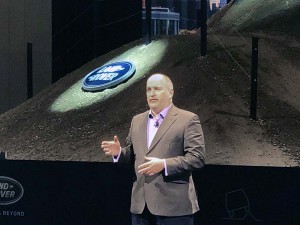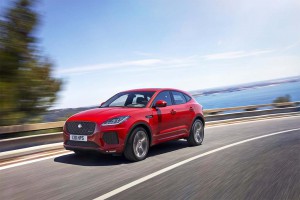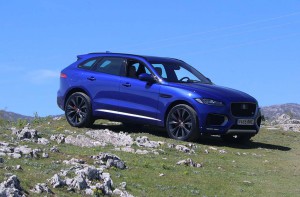
Jaguar's U.S. leader Joe Eberhardt said the speed with which customers moved from cars to SUVs was problematic.
While the surge in SUV and CUV sales has been underway for more than a decade, few could have guessed the pace with which that shift has accelerated during the last few years. And while that’s good news for one of the company’s brands, it has been a major challenge for the other half of Jaguar Land Rover.
Add in what a senior executive calls external “headwinds,” and the Indian-owned automaker posted a loss of 281 million British pounds, or $371.5 million, for the final quarter of 2018. That’s triggered a two-prong turnaround program that, U.S. CEO Joe Eberhardt said, is aimed at making the company “sustainable.”
“I don’t want to say the speed of change took us by surprise, but they were too quick for us to react to immediately. It takes time to transform ourselves to the point we can be profitable again,” Eberhardt said during an interview.
The plan is meant to address both short-term cost issues and longer-term strategic challenges. Among other things, it explores whether the Jaguar side of the company might need to abandon some of its iconic sports cars and sport sedans and coupes, such as the slow-selling XJ flagship.
(Jaguar Land Rover cutting 4,000 jobs in Europe. Click Here for the story.)

The new E-Pace follows on the success of Jaguar's first-ever SUV, the F-Pace, which is slightly larger.
So far, Eberhardt said, the focus is on model variants that are no longer economically viable. It will drop all manual transmission models after 2019, for example. And you’ll no longer see wagons – or, as the British prefer to call them, “shooting brakes” – in the U.S. JLR is also reconsidering the need to market diesels, as demand continues to slide in both the U.S. and Europe.
Looking further into the future, if the shift to utility vehicles continues to curb demand for coupes and sedans, “We have to ask (which products) make sense anymore.”
The saving grace for JLR is its broad portfolio of utility vehicles. The Land Rover side has been expanding its line-up with numerous new models and variants. A second-generation Range Rover Evoque will come to market later this year, followed by an all-new version of the classic Land Rover Defender. Jaguar, meanwhile, now has three crossovers, the E-Pace, F-Pace and I-pace.
“I don’t think we knew how quickly that trend would happen when we did the F-Pace, E-Pace and I-Pace, so I guess you could call it luck,” Eberhardt said. “I can guarantee at the time, nobody said it would be 70% at planning meetings. The good news is that we have the product. The question now is how we react on the downside with cars that are not in demand.”
(Click Here for our first look at the 2020 Jaguar XE.)
All told the E- and F-Pace CUVs now account for 70% of the Jaguar brand’s volume. The I-Pace is just rolling into showrooms and it’s still far too early to tell what sort of demand there will be, said Eberhardt, who joined JLR in December 2013.
“The I-Pace is a really cool car and it drives real well. It may be the future but we just don’t know yet. It’s tough for the industry, as a whole, to know what the natural demand is,” said Eberhardt. “Electrification could become consumer driven. What it needs is for the industry addressing customer pain points: range, charge times and costs.”
While the German-born executive said he is confident the two JLR turnaround plans, dubbed “Charge,” and “Accelerate,” can help deliver a 2.5 billion pound, or $3.3 billion, improvement to JLR’s bottom line, he acknowledged there are plenty of unknowns that could slam the automaker hard. These include Britain’s planned exit from the European Union, or Brexit, later this month, as well as U.S. President Donald Trump’s threat to enact tariffs of up to 25% on foreign-made vehicles.
(Jaguar Land Rover cutting production to a three-day week. Click Here for the story.)
“What keeps me awake (at night) are the challenges we face that could be exacerbated by things outside of our control,” said Eberhardt. “We’ve lived through shifts in market demand before. But there are unknowns on the trade side that you can’t plan for.”

